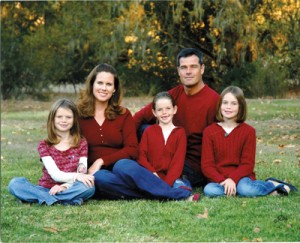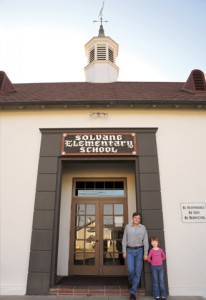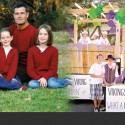COVER STORY —Solvang’s Danish-American generations in 2011
Often described as more Danish than Denmark, Solvang retains the flavor of its founders’ culture a full century after its inception. Graceful windmills, Old World architecture, and the aromatic drift of Danish foods— from meaty frikadeller to fresh pastries—serves as a reminder of the town’s origins and enduring character.
While other California towns have lost the orange and walnut groves that once distinguished them, Solvang still boasts an abundance of active farms and ranches. In fact, the sunny fields that first caught the eyes of the incoming Danes back in 1911 still embrace the village on all sides.
Solvang’s Danish character remains distinct, in part, because in 1947 second- and-third-generation Danish-Americans began using 19th century Denmark as a template for downtown construction. Today, Solvang constitutes something of a time capsule, because even in much of Denmark itself that model has given way to more modern styles.
Located along a rural highway bounded by the ocean in the west and mountains in the east, Solvang remains relatively insulated from the corrosive clamor of the outside world. The quiet tree-lined streets evoke an earlier time, the young people willingly engage in community life, and the town’s heart beats with vibrant activity and a spirit of volunteerism.
These traditional qualities reflect the values and accomplishments of Solvang’s earliest Danes, hardworking immigrants who cherished family life and civic involvement. Folk traditions informed their activities—from music and dancing to learning and worship—and remain at the core of local life.
Pioneers with names like Nielsen, Jensen, Rasmussen, and Skytt built such a solid foundation—and in such a beautiful spot—that 100 years later, the population still includes many of their descendants. Danish surnames pepper local directories, lending a sense of continuity that’s often missing from contemporary communities.
A thread of shared history connects Solvang’s longtime residents, who carry on with the same dedication as those pioneers who donated land for the first Lutheran church, helped to repair the Mission bell tower for their Catholic neighbors, or prepared meals for the workers who built the town.

“Everybody cares about everybody here in the Valley and looks out for them,” declares Rodney Nielsen, whose great-grandfather Marcus owned Nielsen’s Market in 1914. “I think that’s what really makes Solvang special. It’s the community itself, the people.
“It’s an amazing place to grow up,” he continues. “Everybody is so generous and genuinely concerned about their neighbors. You can see it when somebody gets sick and everybody rallies around.”
According to Rodney, his son, Andrew, 10, delights in the simple acts of walking or riding his bike to school, and then heading to the river to play.
“I know for myself growing up here, it’s such a wonderful rural setting,” says Rodney, manager of Nielsen’s Market. “I think Andrew’s enjoying the same kinds of things I did.”
Agreeing with his father, Andrew admits, “I like that it’s a little town and almost everyone knows each other. There’s not much drama going around.
“I want to stay here,” he adds. “I’m fifth generation, so I want to keep it here.”
Andrew’s cousin, Christiana, also 10, praises the weather and appreciates the fact that Solvang is a peaceful place where her friends live close by and she can ride her bike into town. She plans to remain in the area and continue to celebrate her Danish heritage.
“We have all these cool traditions,” Christiana says. “Like, we make special foods, and at Christmas we put an almond in rice porridge, and whoever finds the almond gets a little prize. Last year we got a gift card, but a couple of times we’ve gotten little dolls.”
Christiana’s mother, Betina Nielsen Heron, is Rodney’s sister. As a young adult, she left the Valley for several years but soon felt the urge to return.

“I just love my small community,” Betina says. “My brother and parents are here, and I thought raising a family here would be safer than most places. We’re such a transient society that most families are scattered, and it’s neat to have deep roots.”
Like most longtime residents, Betina’s family takes part in Danish Days, an annual celebration that’s part reunion, part ethnic street fair, and also a lively tourist attraction. Organized by local Danes and held the third weekend in September, it offers a true representation of the Danish spirit of fun, including folk dances, live music, and a float-filled parade, all serving to preserve venerable Danish customs.
“For me, Danish Days is important because it makes our cultural heritage come alive,” says Betina. “We get to see all the Danes and remember what’s important and unique about the founding of our town.”
Everyone turns out for Danish Days, but none with greater thunder than Ken Andersen and his family, descendants of the Roths, who came to Solvang in 1911, and the Christen V. Nielsens, who arrived in 1917. For the parades they create floats with dazzling elements, including Viking ships, windmills, booming music, and once a waterslide in the form of a giant clog.
“Each year we try to do something people don’t expect,” reveals Ken, manager of Nielsen Building Materials, founded by his grandfather, Christen V. Nielsen, in 1932. “It’s such a rush to get the crowd excited to see what’s coming around the corner. And if you make it fun for the kids, they can’t wait to get back and do it again next year.
“I’ve been part of Danish Days since I was born, literally,” he laughs, “and my kids have been part of it since they were born. I don’t think they’ve ever seen a parade, because they’ve always been in it!
“It’s important to know where you came from, your heritage,” he adds. “It makes you part of the family, part of a community.”

Ken’s daughter, Emma, 15, who experienced her first Danish Days parade while still a baby, describes her earliest memories of the festival.
“Everybody would be dancing,” she remembers. “I’d dance with my grandpa and dad, and that was really special. And in the mornings, I would help cook aebleskivers with my aunt. It was fun!”
“Everyone enjoys Danish Days,” she says. “It means everything to me and I love being part of it.”
Emma’s aunt, Donna Andersen Beehler, who owns The Home Connection in Solvang, recalls the rigors of Danish Days when she was a child. Not only did she clap and turn with the Danish family folk dancers, she also performed gymnastics to the regimented beat of instructor Viggo Tarnow’s piccolo and then joined the parade with the Solvang marching band.
“That’s how we grew up,” she smiles, “and it’s really an honor to see these kids follow in our footsteps. It’s so fun to see their faces when they’re performing. They’ve got a lot of pride.
“Danish Days isn’t only important for the town,” she declares, “but for local families, and the tradition that it teaches the younger kids. It’s been such a part of our family for so many years.”

Like all local Danish children, Russell Beehler, Donna’s 16-year-old son, has grown up with an intimate knowledge of his roots.
“My whole life has been based on Danish heritage,” Russell says, “and I’m really glad to be part of it. It means something special to be Danish, to know that this is where you came from. It’s like full family history.
“After college,” he adds, “I plan on living in the Valley, helping to take over the Danish traditions and keep things going.”
A third-generation resident of Solvang, Bruce Pedersen has taught math at Solvang School for 17 years. During that time, he has noticed that many of his students may ache to move away, but once they get a little older, they realize what a wonderful place it is to raise a family.
“It’s a small, tight-knit community,” Bruce says. “There are a lot of second, third, and fourth generation Valley people who still have parents and perhaps grandparents here, so it’s home.”
During a stint in the army, Bruce visited Denmark, where he found the people to be more outgoing and hospitable than anywhere else in Europe. Happy to return to Solvang, he discovered that his Danish roots gave him a special bond with the region and inspired him to get involved with the Danish Days organizing committee.
Bruce’s daughter, five-year-old Stephanie, already has her own Danish outfit to wear in the Danish Days children’s parade. As for the simple, small town pleasures of Solvang, she likes to eat Napoleon hats fresh from the bakery and ride the horse-drawn trolley.
Once a year, when Solvang hosts Danish Days, anyone can be Danish, at least for a day or two. Locals don colorful costumes and dance in the streets, while tempting aromas fill the air, bringing to life the heritage that lies at the heart of this rare gem of a town.
“I think everybody likes to know their past,” muses Rodney Nielsen, “and I’m proud of my Danish history. It’s something I’ve always known, growing up in Solvang and being Danish. It’s who I am.”










